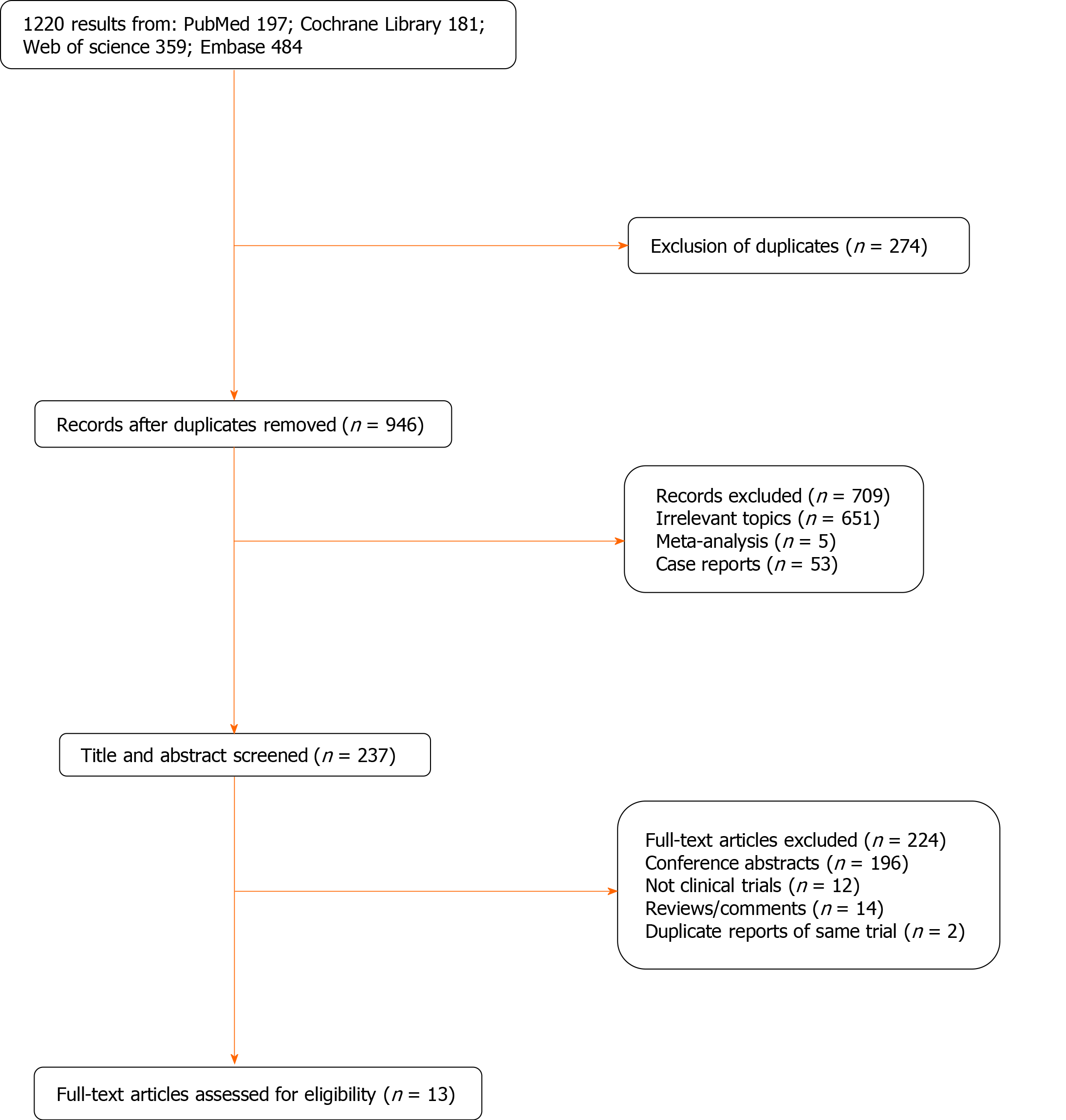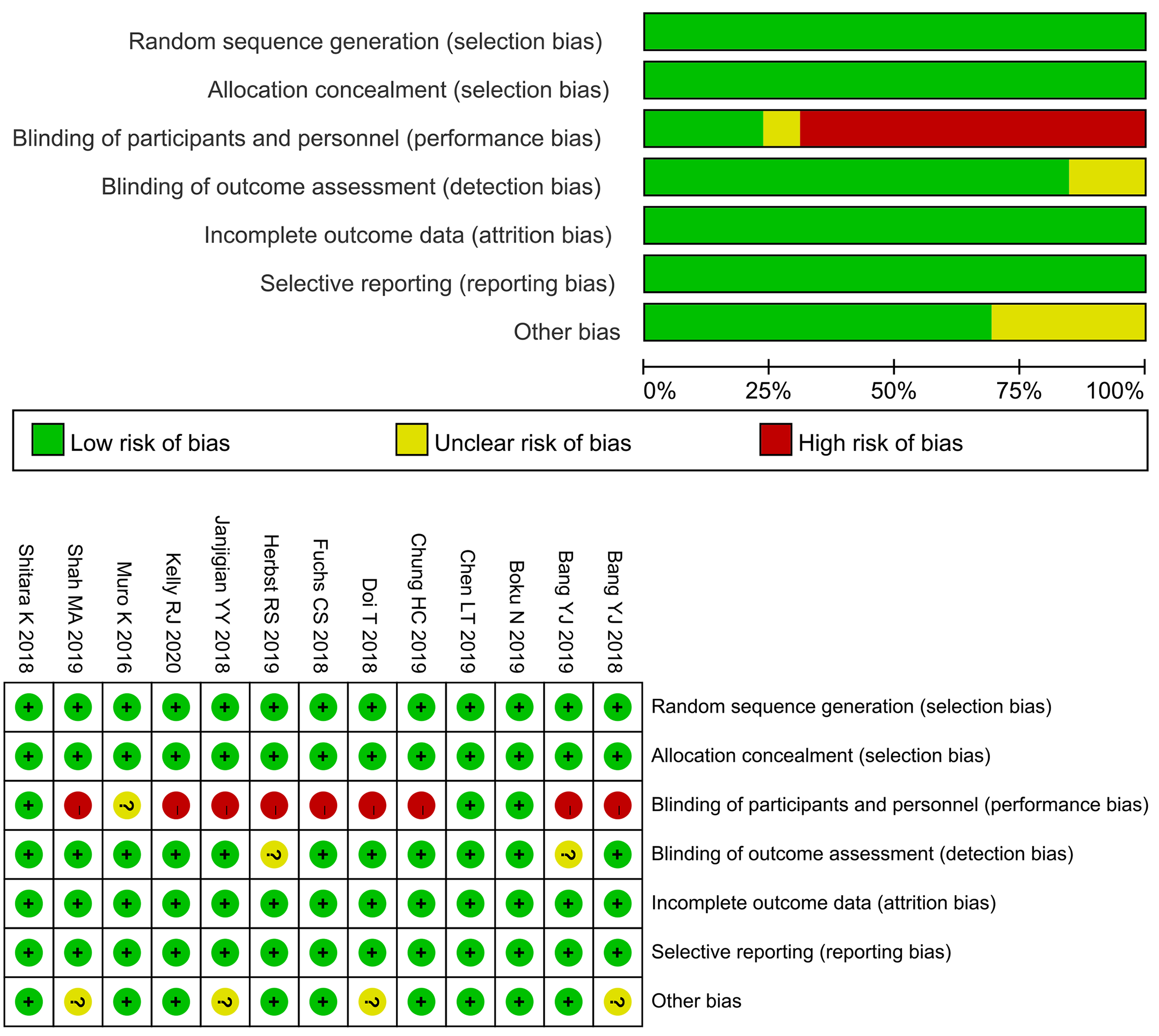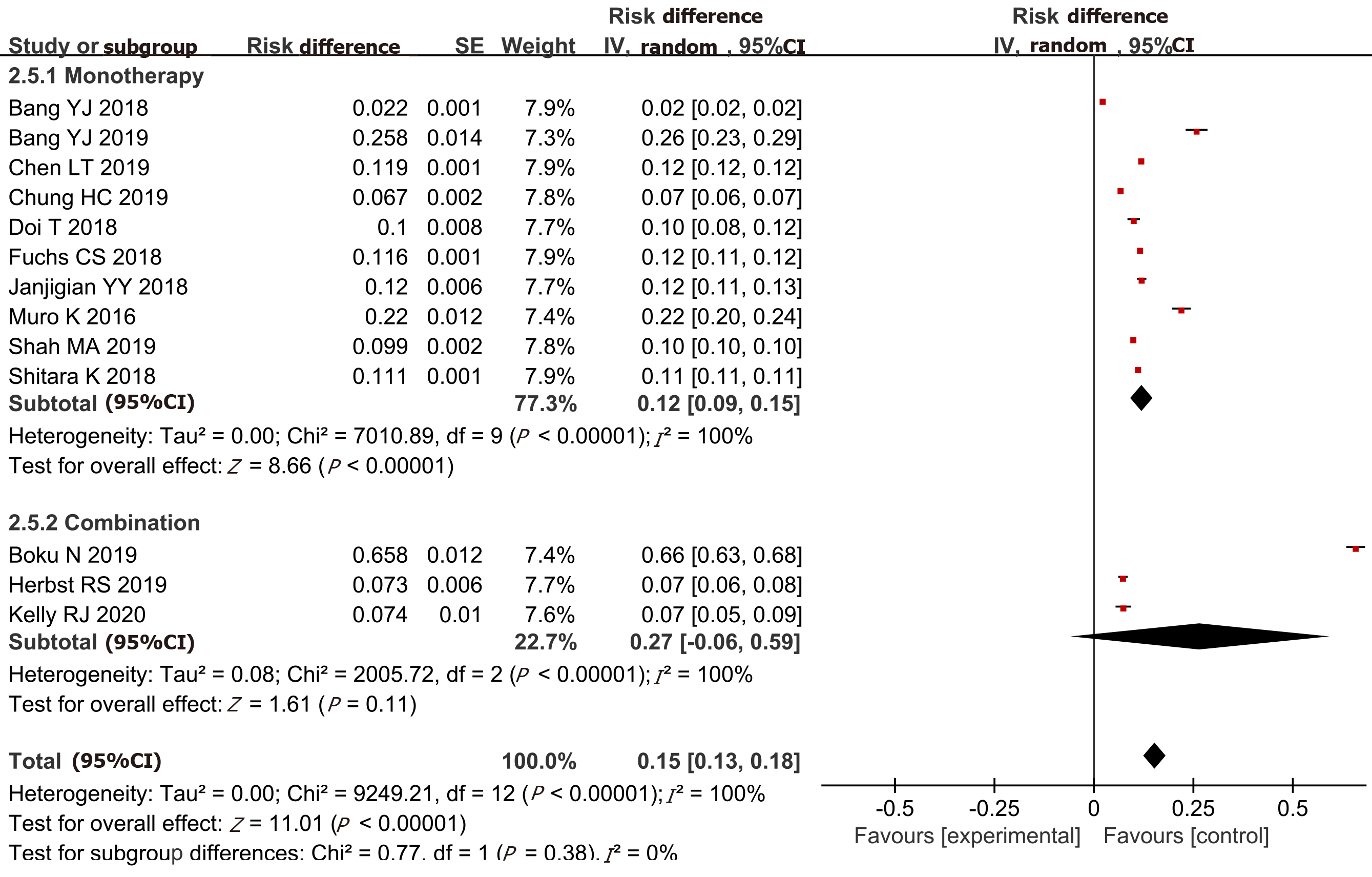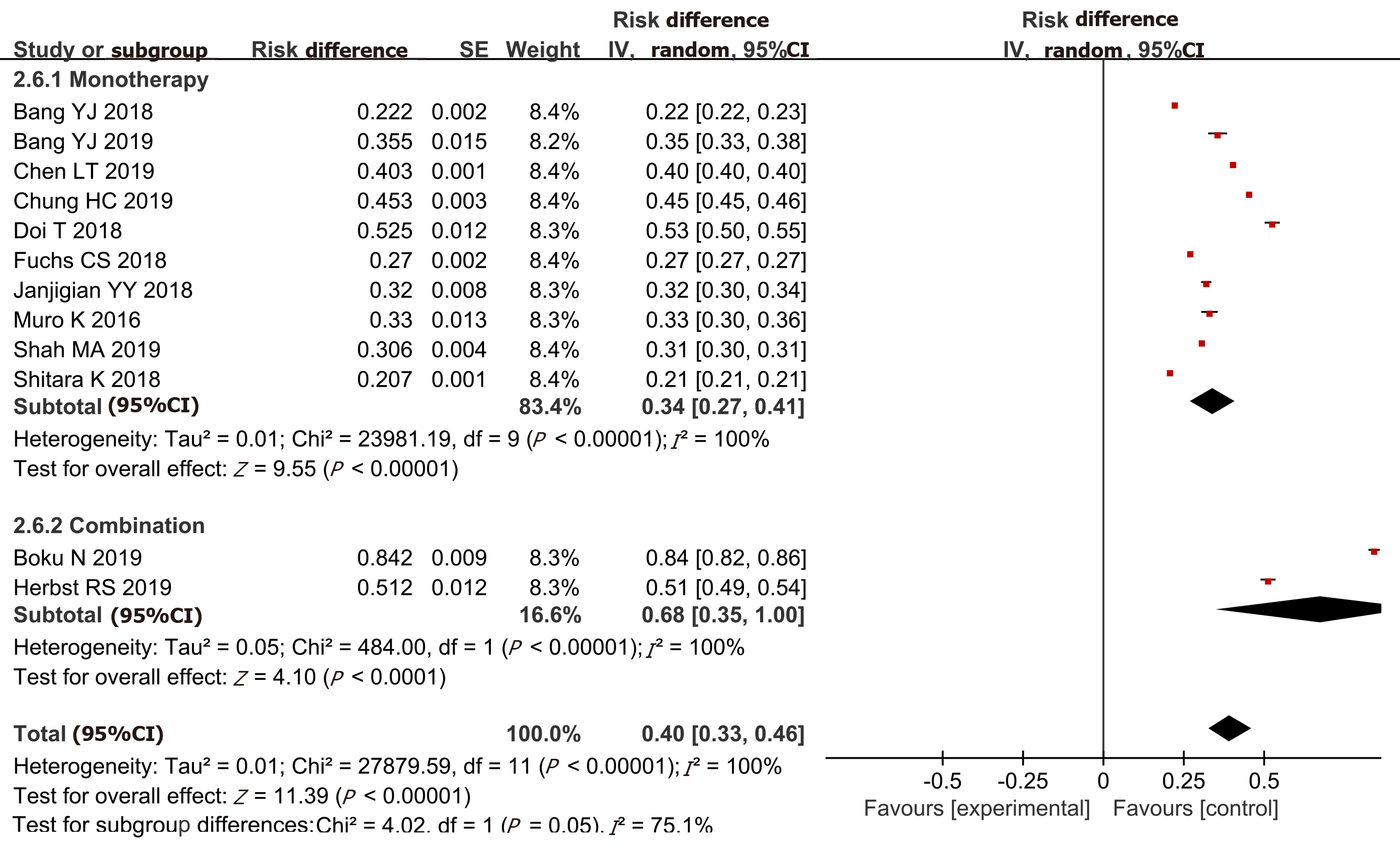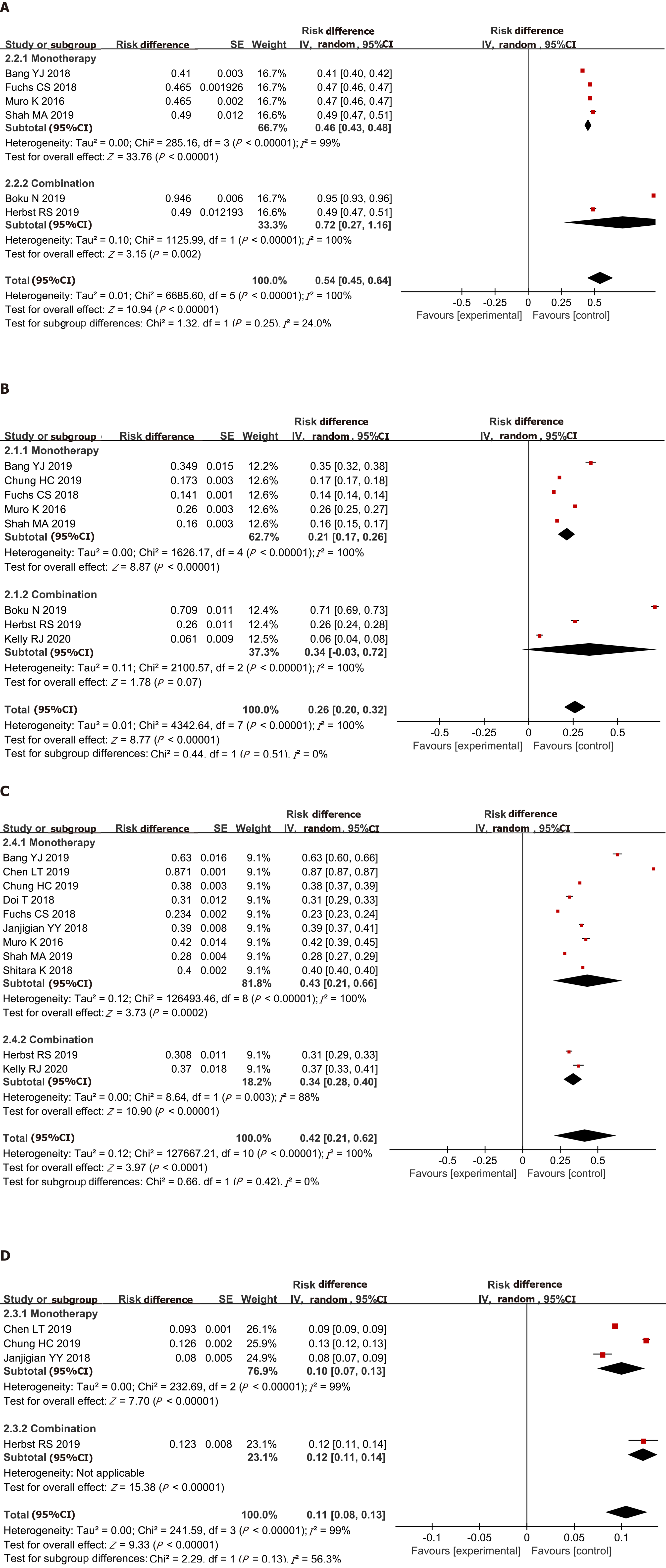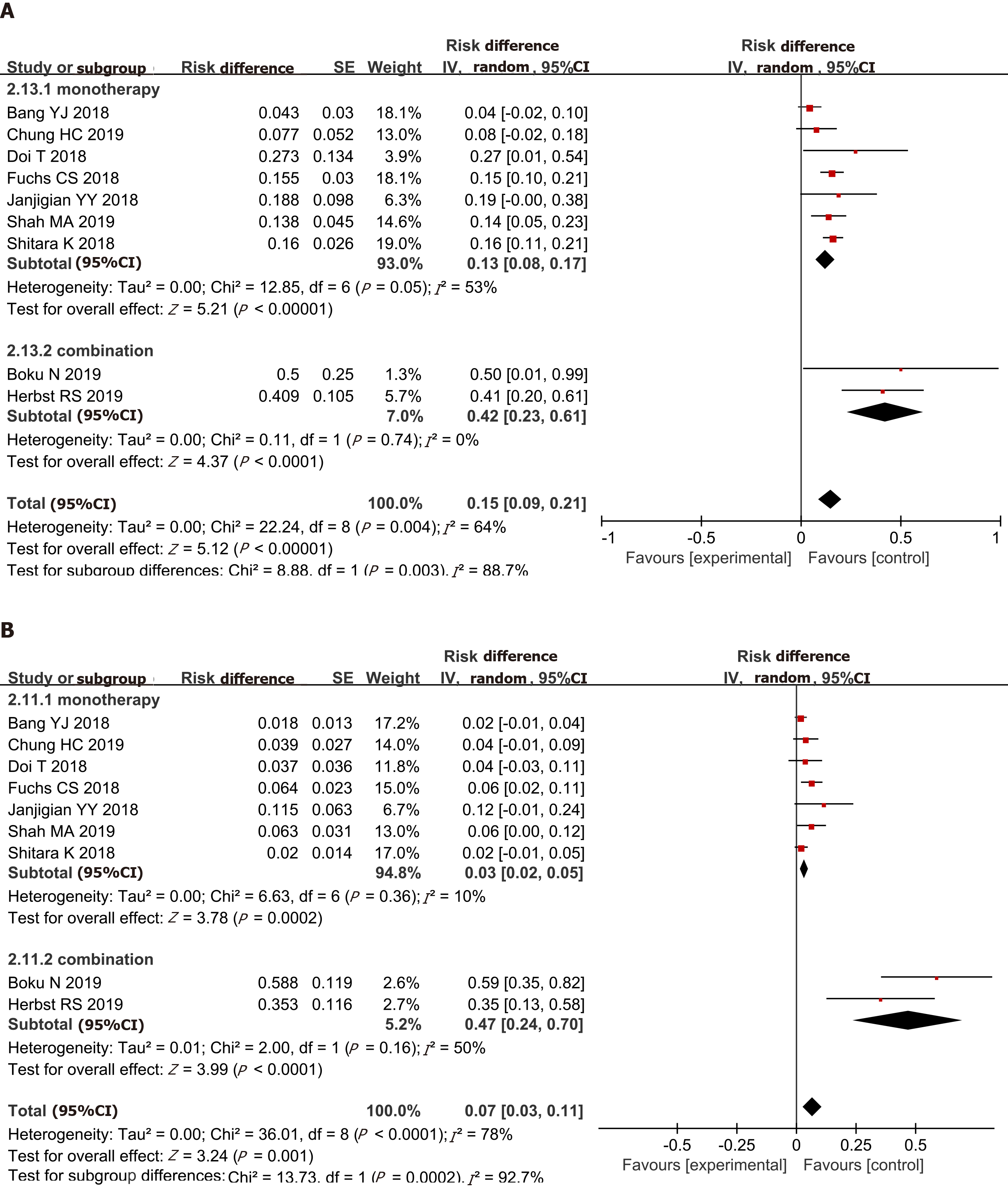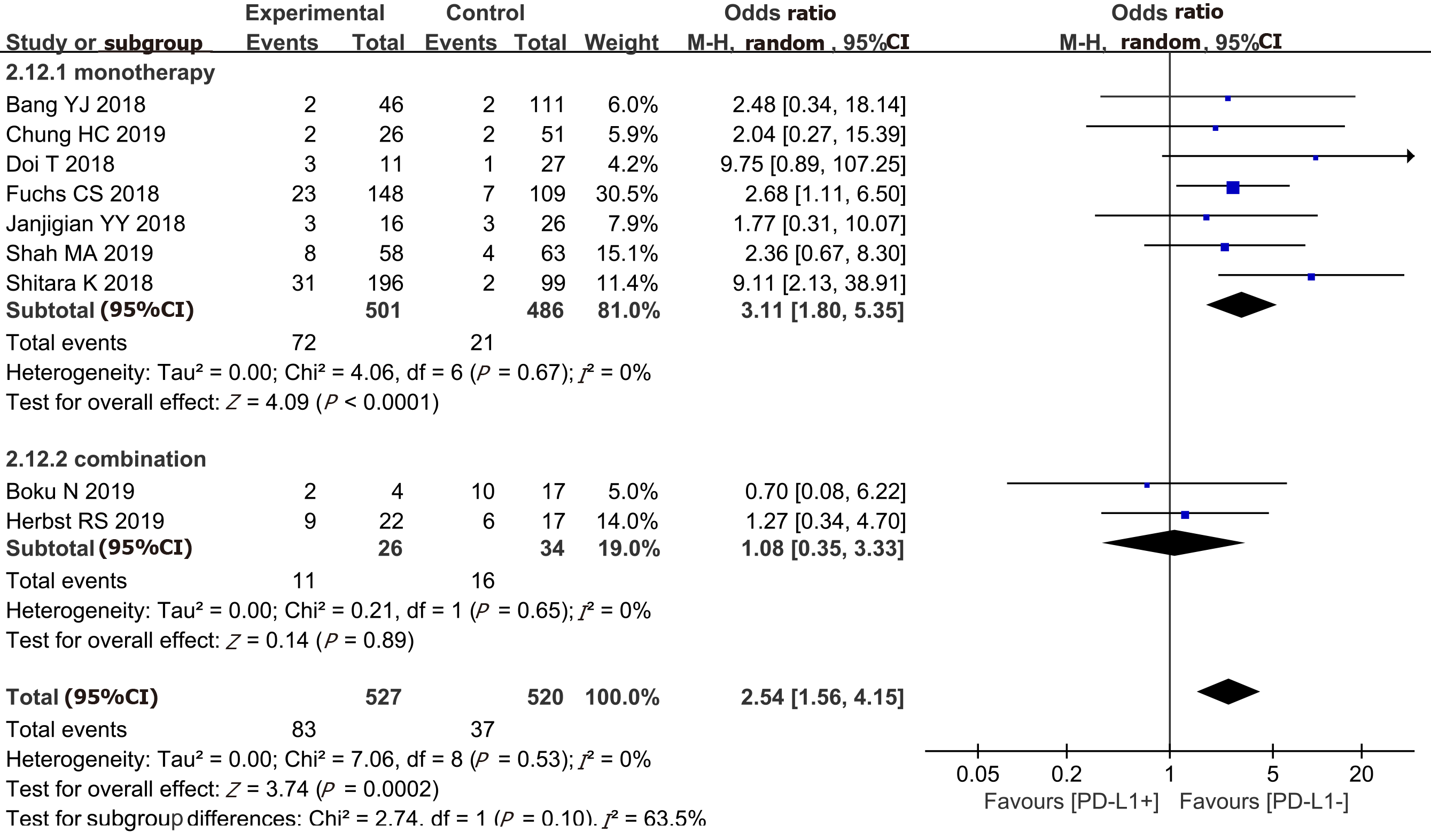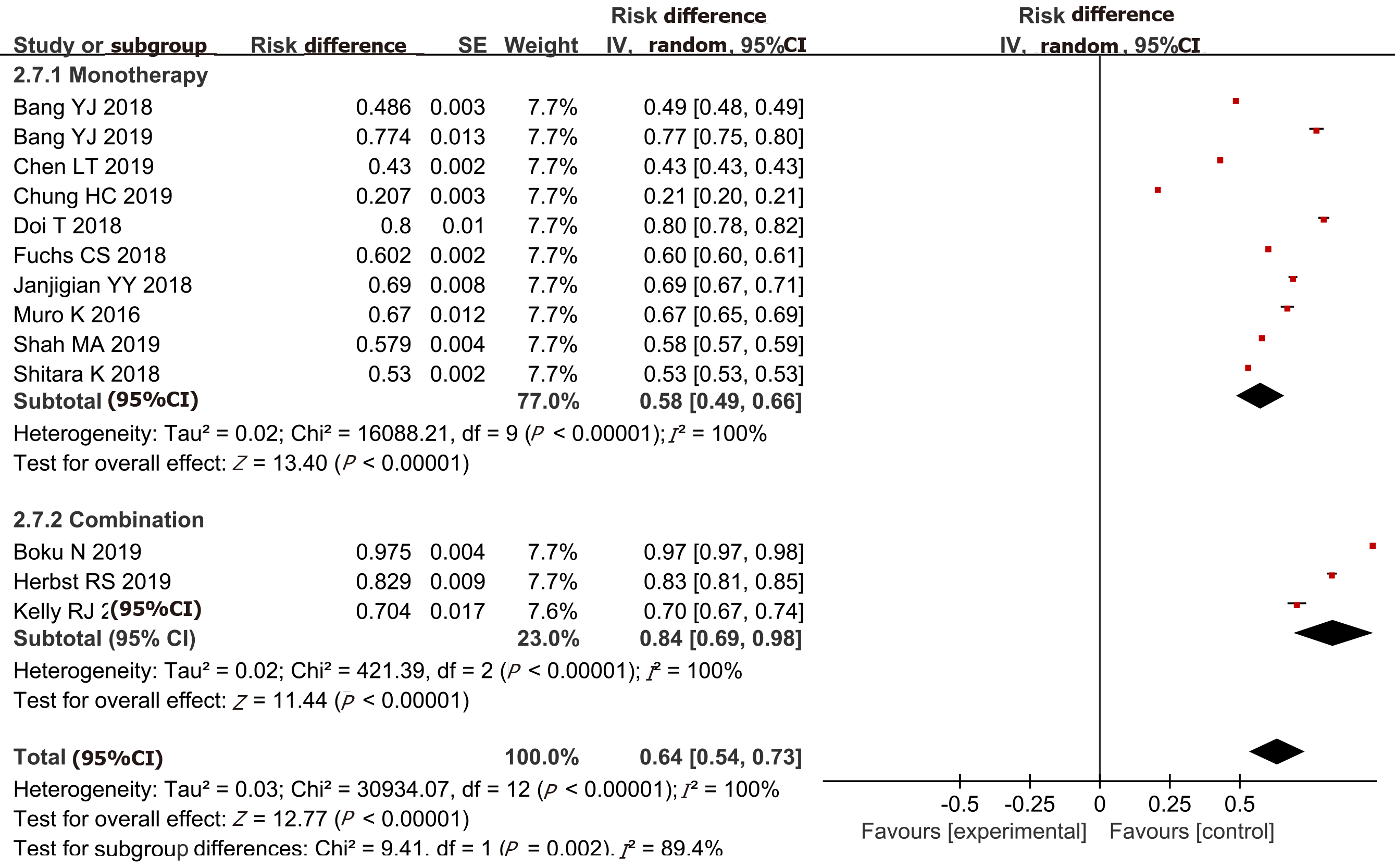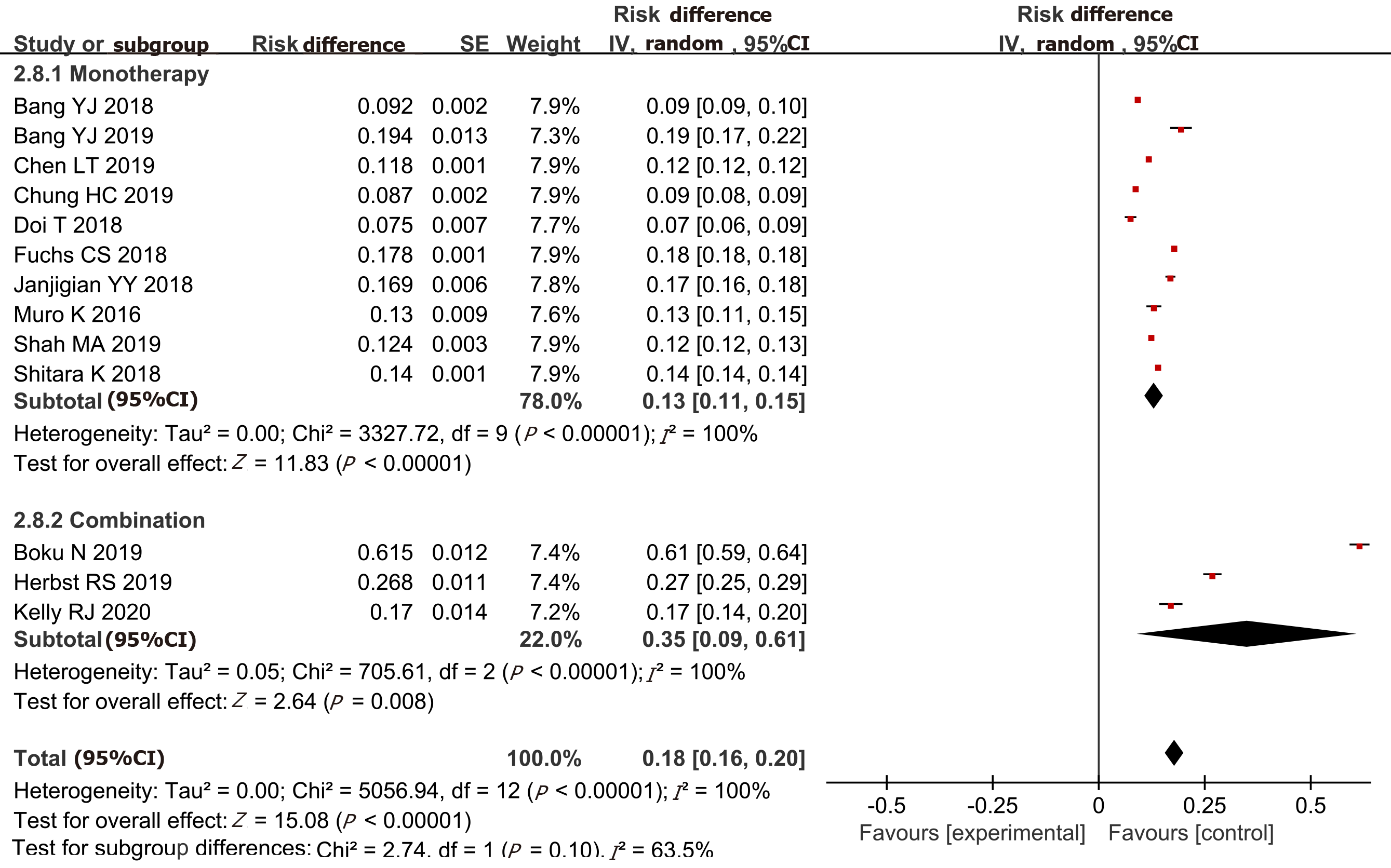Published online Nov 15, 2020. doi: 10.4251/wjgo.v12.i11.1346
Peer-review started: June 9, 2020
First decision: July 4, 2020
Revised: July 15, 2020
Accepted: September 18, 2020
Article in press: September 18, 2020
Published online: November 15, 2020
Processing time: 155 Days and 21.2 Hours
Faced with limited and inadequate treatment options for patients with advanced gastric cancer or gastroesophageal junction cancer (GC/GEJC), researchers have turned toward, with the support of promising clinical trials, anti-PD-1/anti-PD-L1 antibody therapy. But there are also different clinical trial results. To better assess its efficacy and safety, we integrated data from 13 eligible studies for a systematic review and meta-analysis.
To comprehensively evaluate the efficacy and safety of anti-PD-1/anti-PD-L1 antibody therapy in the treatment of advanced GC/GEJC patients.
PubMed, Web of Science, Cochrane Library ,and EMBASE databases were searched to identify eligible articles with outcomes including objective response rate (ORR), disease control rate (DCR), overall survival (OS), progression-free survival (PFS), and adverse events (AEs) of anti-PD-1/anti-PD-L1 antibody therapy.
Our study encompassed a total of 13 trials totaling 1618 patients. The outcomes showed a pooled ORR and DCR of 15% (95% confidence interval [CI]: 14%-18%) and 40% (95%CI: 33%-46%), respectively. The pooled 6-mo OS and PFS were 54% (95%CI: 45%-64%) and 26% (95%CI: 20%-32%), respectively, and the 12-mo OS and PFS were 42% (95%CI: 21%-62%) and 11% (95%CI: 8%-13%), respectively. In addition, the incidence of any-grade AEs and grade ≥ 3 AEs was 64% (95%CI: 54%-73%) and 18% (95%CI: 16%-20%), respectively. Most importantly, PD-L1 positive patients exhibited a higher ORR rate than PD-L1 negative patients (odds ratio = 2.54, 95%CI: 1.56-4.15).
Anti-PD-1/anti-PD-L1 antibody therapy has shown promising anti-tumor efficacy with manageable AEs in advanced GC/GEJC patients, with PD-L1 overexpressing patients exhibiting a higher ORR. What is more, the clinical efficacy of anti-PD-1/PD-L1 combined with traditional chemotherapy drugs is even better, although the occurrence of AEs still causes considerate concerns.
Core Tip: Anti-PD-1/anti-PD-L1 antibody therapy, such as nivolumab and pembrolizumab, which has been approved by the FDA for marketing, enhances the body′s cellular immune response to anti-tumor effects by regulating T cell function. At present, it has become the first-line treatment for extensive stage small cell lung cancer and other cancers. In recent years, some clinical trials have also shown that anti-PD-1/anti-PD-L1 antibody therapy has a reliable effect in advanced gastric cancer or gastroesophageal junction cancer (GC/GEJC) patients, but there is still controversy. The main purpose of this meta-analysis was to comprehensively evaluate the efficacy and safety of anti-PD-1/anti-PD-L1 antibody therapy in the treatment of advanced GC/GEJC patients.
- Citation: Yang L, Dong XZ, Xing XX, Cui XH, Li L, Zhang L. Efficacy and safety of anti-PD-1/anti-PD-L1 antibody therapy in treatment of advanced gastric cancer or gastroesophageal junction cancer: A meta-analysis. World J Gastrointest Oncol 2020; 12(11): 1346-1363
- URL: https://www.wjgnet.com/1948-5204/full/v12/i11/1346.htm
- DOI: https://dx.doi.org/10.4251/wjgo.v12.i11.1346
Gastric cancer (GC) is the fifth most frequently diagnosed cancer and the third leading cause of cancer death worldwide[1]. Although GC incidence has been declining globally, there were still 1033701 new GC cases and 782685 death counts in 2018, with overall half occurring in East Asia, especially China[2]. Because GC patients often present nonspecific symptoms, diagnosis occurs predominantly at an advanced stage, where approximately 50% of patients have already developed locally advanced or metastatic tumor, bringing the 5-year survival rate from less than 30%[3,4] down to approximately 15%[5-7].
Currently, the primary treatment option for GC patients is surgery and chemotherapy, with especially poor prognosis and overall survival (OS) rate for patients with advanced GC[8,9]. Current clinical guidelines recommend dual or triple platinum/fluorouracil combinations for human epidermal growth factor receptor 2 (HER-2) negative patients, and trastuzumab in combination with platinum and fluorouracil chemotherapy for HER-2 positive patients as the first-line treatment options, and taxanes, irinotecan, or ramucirumab for patients with performance status (PS) 0-1 as the second-line treatment options[10-12]. Nevertheless, despite these treatments, most patients with advanced gastric cancer or gastroesophageal junction cancer (GC/GEJC) continue to deteriorate after treatment[13,14].
Immune checkpoint inhibitors, such as PD-1 and PD-L1 inhibitors, have become the first-line treatment for multiple malignancies[15]. Inhibition of PD-1 and PD-L1 enhances the in vitro response of T cells as well as the antitumor activity in preclinical models[16,17]. The phase I studies with anti-PD-1 drugs, such as nivolumab and pembrolizumab, in non-small-cell lung cancer (NSCLC), advanced melanoma, renal cell carcinoma (RCC), and other solid tumor patients have demonstrated very promising response with controlled side effects. Inspired from this results, PD-1 blockers were studied for further trials and showed excellent response in phase III trial patients with advanced melanoma than in those with NSCLC and RCC[18]. Anti-PD-1/anti-PD-L1 antibody therapies exhibiting success in many clinical trials for various types of tumors regardless of pathologic grade with long-lasting responses and tolerable toxicity[18,19]. At present, the United States Food and Drug Administration (FDA) has approved PD-1 pathway inhibitors for cancer treatment including the monoclonal antibodies nivolumab (anti-PD-1; Bristol-Myers Squibb), pembrolizumab (anti-PD-1; Merck), atezolizumab (anti-PD-L1; Genentech/Rothe), avelumab (anti-PD-L1; EMD Serono/Pfizer), and durvalumab (anti-PD-L1; AstraZeneca).
Several studies have shown the prevalent overexpression of PD-L1 in GC patients, and the expression of PD-L1 plays a key role in cancer immune escape and related tumor progression and poor prognosis[20,21]. Reducing the expression of PD-L1 in human gastric cancer cell line SGC-7901 can significantly inhibit cell proliferation and migration and tumor growth in subcutaneously transplanted mouse models[22]. In addition, many clinical studies have initially shown that PD-L1 blockers can significantly inhibit the tumor progression of many advanced cancers such as melanoma, GC, non-small cell lung cancer, ovarian cancer and so on[23,24]. Thus, anti-PD-1/anti-PD-L1 antibody therapy seemed promising as a potential approach for GC/GEJC.
In the meantime, several clinical trials have already evaluated the efficacy of anti-PD-1/anti-PD-L1 antibody therapy in advanced GC/GEJC patients, and the results show that this therapy has good anti-tumor activity and controllable adverse reactions for advanced GC/GEJC patients. However, one study suggested that not all tumors expressing PD-L1 respond to PD-1/PD-L1 inhibitors[16]. And the treatment regimen has not been included in the authoritative clinical practice guidelines, such as EMSO GC diagnosis and treatment guidelines, which means that there is yet no scholarly consensus on the efficacy and safety of PD-1/PD-L1 inhibitors in the treatment of advanced GC/GEJC. To address this need, we meta-analyzed all published clinical studies based on the Preferred Reporting Items for Systematic Reviews and Meta-analyses (PRISMA) statement[25].
PubMed, Web of Science, the Cochrane Library, and Embase were searched from inception up to March 5, 2020 using the following MeSHs headings (Gastric Cancer OR Stomach Cancer OR Stomach Neoplasm OR Gastric Neoplasm OR GC OR gastroesophageal OR Gastro Esophageal Junction Cancer OR GEJC) AND (Nivolumab OR MDX-1106 OR ONO-4538 OR BMS-936558 OR Opdivo OR Pembrolizumab OR lambrolizumab OR Keytruda OR MK-3475 OR SCH-900475 OR Atezolizumab OR anti-PDL1 OR MPDL3280A OR Tecentriq OR RG7446 OR Durvalumab OR MEDI4736 OR Imfinzi OR Avelumab OR Bavencio OR MSB0010682 OR MSB0010718C).
The literature included in this study must meet all of the following criteria: (1) Prospective clinical trials in patients with advanced GC/GEJC; (2) Patients in the immunotherapy group were treated with anti-PD-1/PD-L1 drugs; and (3) The literature provides relevant anti-tumor activity and safety data [objective response rate (ORR), disease control rate (DCR), OS, progression-free survival (PFS), adverse events (AEs), or grade ≥ 3 AEs].
The exclusion criteria for this study were as follows: (1) Conference abstracts, case reports, comments, editorials, etc.; (2) For multiple publications that have been determined to be reported in the same clinical study, the publication with the most complete publication data is qualified; and (3) The literature information was insufficient to extract the required useful data.
During the preliminary screening process, relevant studies were first independently selected by two authors (Yang L and Dong XZ) of this study. Any disagreements were then resolved through mutual discussion and consultation.
Data were extracted independently by two researchers, including the name of the first author, year of publication, trial name, trial phase, number of participants, interventions, OS, PFS, ORR, DCR, AEs, tumor characteristics, and expression level of PD-L1 (positive expression as > 1% and negative expression as ≤ 1%). Any unavailable data were recorded as “NA”.
Bias risk was assessed using the Cochrane Collaboration's tool[26] in the following domains: Random sequence generation, allocation concealment, blinding of outcome participants and personnel, blinding of outcome assessment, incomplete outcome data, selective reporting, and other biases. Each result was classified as low risk, high risk, or unclear risk. Quality assessment was done independently by two researchers with disagreements solved through discussion.
To evaluate the efficacy of anti-PD-1/anti-PD-L1 antibody, the overall ORR and DCR as well as the combined OS and PFS rates (both 6 mo and 12 mo) were calculated. To assess its safety, the overall risk of AEs and grade ≥ 3 AEs were calculated. All statistical calculations were performed using Review Manger version 5.3 (Cochrane Collaboration's Information Management System) and STATA version 14.0 (STATA, College Station, TX, United States). Statistical heterogeneity across studies was assessed using the Cochran Q chi-square test and the I2 index. Whence significant heterogeneity was determined with either I2 > 50% or P value < 0.1, the random-effects model was applied[27]. Sensitivity analysis was performed by removing individual studies one by one to test the reliability of the results. Publication bias was determined using Begg’s and Egger’s methods.
The whole process of study selection is shown in Figure 1. Out of the 1220 initially retrieved records, 946 remained after the removal of duplicates. After the screening of titles and abstracts, 709 records were excluded and 237 were reviewed for full text. After further removal of conference reports, reviews, duplicates, and studies without clinical trials, 13 records were defined eligible[28-40].
The detailed characteristics of the included studies are summarized in Table 1. The 13 eligible studies include six single-arm trials[29,33-35,38,39], five randomized controlled trials (RCTs)[28,30,31,37,40], and two dose-escalation cohort expansion studies[32,36]. A total of 1618 GC/GEJC patients were included, of whom 787 received pembrolizumab, 429 received nivolumab, 375 received avelumab, and 27 received durvalumab. Pembrolizumab was intravenously administered at 200 mg in five trials[29,34,35,39,40] and 10 mg/kg in another[38]. Nivolumab was intravenously administered at 3 mg/kg in two studies[31,36], and 360 mg in another[30]. Avelumab and durvalumab were administered at 10 mg/kg[28,32,33] and 20 mg/kg[37], respectively.
| Ref. | Trial | Clinical trials. gov, No. | Study design | Phase | Case, experimental vs control, (n) | Intervention methods | ORR (%) | DCR (%) | 12-mo OS (%) | 12-mo PFS (%) |
| Bang | JAVELIN Gastric 300 | NCT02625623 | RCT | III | 371, 185 vs 186 | Avelumab 10 mg/kg Q2 W vs paclitaxel 80 mg/m2 or irinotecan 150 mg/m2 1, 8, 15 d of 4-wk cycles. | 2.2 | 22.2 | NA | NA |
| Bang | KEYNOTE-059 (cohorts 2 and 3) | NCT02335411 | Single-arm | II | 31 | Pembrolizumab 200 mg on day 1 of 21-d cycles. | 25.8 | 35.5 | 63.0 | NA |
| Boku | ATTRACTION-4 | NCT02746796 | RCT | II | 40, 21 vs 19 | Nivolumab 360 mg Q3 W + SOX or Cape OX. | 65.8 | 84.2 | NA | NA |
| Chen | ATTRACTION-2 | NCT02267343 | RCT | III | 493, 330 vs 163 | Nivolumab 3 mg/kg Q2 W vs placebo 3 mg/kg Q2 W. | 11.9 | 40.3 | 87.1 | 9.3 |
| Chung | JAVELIN Solid Tumor | NCT01772004 | Dose-escalation | I | 150 | Avelumab 10 mg/kg Q2 W. | 6.7 | 45.3 | 38.0 | 12.6 |
| Doi T | JAVELIN Solid Tumor JPN trial | NCT01943461 | Single-arm | I | 40 | Avelumab 10 mg/kg Q2 W | 10.0 | 52.5 | 31.0 | NA |
| Fuchs | KEYNOTE-059 (cohorts 1) | NCT02335411 | Single-arm | II | 259 | Pembrolizumab 200 mg Q3 W. | 11.6 | 27.0 | 23.4 | NA |
| Herbst | JVDF | NCT02443324 | Single-arm | Ia/b | 41 | Pembrolizumab 200 mg on day 1 + ramucirumab 10 mg/kg days 1-8. | 7.3 | 51.2 | 30.8 | 12.3 |
| Janjigian et al[36] 2018 | CheckMate-032 | NCT01928394 | Dose-escalation | I/II | 59 | Nivolumab 3 mg/kg Q2 W. | 12.0 | 32.0 | 39.0 | 8.0 |
| Kelly | NA | NCT02340975 | RCT | Ib/II | 27 | Durvalumab 20 mg/kg + tremelimumab 1 mg/kg Q4W. | 7.4 | NA | 37.0 | NA |
| Muro | KEYNOTE-012 | NCT01848834 | Single-arm | Ib | 39 | Pembrolizumab 10 mg/ kg Q2 W. | 22.0 | 33.0 | 42.0 | NA |
| Shah | KEYNOTE-180 | NCT02559687 | Single-arm | II | 121 | Pembrolizumab 200 mg Q3 W. | 9.9 | 30.6 | 28.0 | NA |
| Shitara | KEYNOTE-061 | NCT02370498 | RCT | III | 592, 296 vs 296 | Pembrolizumab 200 mg Q3 W vs paclitaxel 80 mg/m2 1, 8, 15 d of 4-wk cycles | 11.1 | 20.7 | 40.0 | NA |
The quality assessment was conducted using Review Manger 5.3. Details of risk of bias for each study are presented in Figure 2. Due to the particularity of clinical trials in cancer treatment, the single-arm and dose-escalation trails are inherently considered high-risk in terms of bias. The 13 studies included in this meta-analysis were low-risk in terms of random sequence generation, allocation concealment, incomplete outcome data, and selective reporting. Blinding of outcome assessment and other biases might exist in two and four studies, respectively. Bias (blinding of outcome participants and personnel) was high risk. Generally speaking, the quality assessment of the included studies had a low risk of bias.
ORR, which is the optimal number of partial responses (PR) or complete responses (CR) divided by the total number of patients receiving treatment, for all 1618 patients was recorded. Overall, the pooled ORR was 15% (95% confidence interval [CI]: 14%-18%, P < 0.001), exhibiting significant heterogeneity (I2 = 100%, P < 0.001) (Figure 3). Within subgroup analysis, the pooled ORR for monotherapy was 12% (95%CI: 9%-15%, P < 0.001) and 27% (95%CI: -6%-59%, P < 0.001) for combined therapy.
Only 12 trails including 1591 patients reported DCR, which is the sum of patients diagnosed with complete remission, partial remission, or stable disease. The pooled DCR was 40% (95%CI: 33%-46%, P < 0.001), exhibiting high heterogeneity (I2 = 100%, P < 0.001) (Figure 4). Compared to patients in the monotherapy group, patients in the combination group had a higher DCR (68%, 95%CI: 35%-100% vs 34%, 95%CI: 27%-41%).
The 6-mo OS of 685 patients in six trials and 6-mo PFS of 708 patients in eight trails were reported. The pooled 6-mo OS and PFS were 54% (95%CI: 45%-64%, P < 0.001, Figure 5A) and 26% (95%CI: 20%-32%, P < 0.001, Figure 5B), respectively. Furthermore, the 6-mo OS and PFS of patients in the monotherapy group were 46% (95%CI: 45%-48%, P < 0.001) and 21% (95%CI: 17%-26%, P < 0.001), respectively, significantly lower than the corresponding OS of 72% (95%CI: 27%-116%, P < 0.001) and PFS of 34% (95%CI: 3%-72%, P < 0.001) of patients in the combination group.
The 12-mo OS and PFS were reported in 11 trials involving 1393 and 4 trials involving 580 patients. The pooled 12-mo OS and PFS were 42% (95%CI: 21%-62%, P < 0.001, Figure 5C) and 11% (95%CI: 8%-13%, P < 0.001), respectively (Figure 5D). However, contrary to the 6-mo OS and PFS results in the subgroup analysis, the 12-mo OS of patients in the monotherapy group was 43% (95%CI: 21%-66%), significantly higher that (34%; 95%CI: 28%-40%) of patients in the combination group, while the 12-mo PFS (12%, 95%CI: 11%-14%) of patients in the combination group was only slightly higher than that (10%, 95%CI: 7%-13%) of patients in the monotherapy group.
Of the 1191 patients in nine trials, the ORR was 15% (95%CI: 9%-21%, P < 0.001, Figure 6A) for patients with positive (> 1%) PD-L1 expression and 7% (95%CI: 3%-11%, P = 0.001, Figure 6B) for patients with negative (≤ 1%) PD-L1 expression. In addition, the pooled OR was 2.54 (95%CI: 1.56-4.15, P < 0.001), indicating that the ORR of PD-L1 positive patients was significantly higher than that of negative patients (Figure 7).
Of the 1618 patients included in 13 trials reporting AEs, 869 (53.7%) experienced at least one AE and 237 (14.6%) experienced at least one grade ≥ 3 AE. The overall incidence of any-grade AEs was 64% (95%CI: 54%-73%, P < 0.001, Figure 8) with significantly more patients under the combination therapy than under monotherapy (84% vs 58%). The total incidence of grade ≥ 3 AEs was 18% (95%CI: 16%-20%, P < 0.001). In the monotherapy group, the incidence of grade ≥ 3 AEs was 13% (95%CI: 11%-15%, P < 0.001), which was 22% lower than that of the combination therapy group (Figure 9).
The most common any grade AEs was fatigue (15.8%; 95%CI: 11.1%-20.5%), followed by infusion reaction (13.8%; 95%CI: 1.3%-26.3%), pruritus (13.1%; 95%CI: 9.8%-16.4%), decreased appetite (9.6%), nausea (9.4%), abdominal pain (9.3%), diarrhea (8.3%) and pyrexia (8.0%). The most common grade ≥ 3 AEs was abdominal pain (2.8%, 95%CI: -3.4%-9.0%), and the incidence of other common grade ≥ 3 AEs was fairly low (Table 2).
| Common AE | Any grade (%) | 95%CI | Grade ≥ 3 (%) | 95%CI |
| Fatigue | 15.8 | 11.1-20.5 | 1.2 | 0.6-1.9 |
| Infusion reaction | 13.8 | 1.3-26.3 | 0.6 | -0.2-1.4 |
| Pruritus | 13.1 | 9.8-16.4 | NA | NA |
| Decreased appetite | 9.6 | 5.7-13.5 | 0.9 | 0.2-1.6 |
| Nausea | 9.4 | 4.1-14.6 | 1.4 | -2.5-5.4 |
| Abdominal pain | 9.3 | -9.5-28.1 | 2.8 | -3.4-9.0 |
| Diarrhea | 8.3 | 4.7-11.8 | 0.6 | 0.2-0.9 |
| Pyrexia | 8.0 | 1.3-14.6 | NA | NA |
| Vomiting | 7.8 | 0.1-15.4 | NA | NA |
| Rash | 7.3 | 5.2-9.4 | 0.9 | -0.1-1.8 |
| Arthralgia | 6.2 | 3.4-9.0 | NA | NA |
| Hypothyroidism | 4.4 | 2.0-6.7 | 0.4 | 0-0.9 |
| Elevated AST | 4.1 | 2.1-6.2 | 1.5 | -0.6-3.5 |
| Asthenia | 3.2 | 1.3-5.1 | 0.7 | -0.2-1.6 |
| Elevated ALT | 2.7 | 1.2-4.1 | 0.9 | -0.4-2.1 |
| Pneumonitis | 2.7 | 0-5.4 | 0.5 | 0-1.0 |
| Elevated lipase | 0.9 | -0.4-2.2 | 0.7 | -0.2-1.6 |
| Colitis | 0.8 | 0.2-1.4 | 0.4 | 0-0.8 |
Manual removal of any study for sensitivity analysis found no changes and reverse in the forest plot direction of all the results, indicating that the study results are both reliable and stable. Begg and Egger’s tests on publication bias showed only presence of bias in 12-mo OS (P = 0.015 < 0.05). No publication bias was found in other outcomes (Table 3).
| Test | ORR | DCR | 6-mo OS | 6-mo PFS | 12-mo OS | 12-mo PFS | AEs | Grade ≥ 3 AEs |
| Begg’s P value | 0.669 | 0.945 | 0.452 | 0.902 | 0.161 | 0.734 | 0.583 | 0.760 |
| Egger’s P value | 0.973 | 0.890 | 0.810 | 0.448 | 0.015 | 0.821 | 0.924 | 0.992 |
Immunoregulatory therapy has been shown to be effective in the control of advanced cancer. PD-1, a member of the CD28 family, is a receptor expressed on the surface of activated T cells that inhibits their activation and promotes apoptosis[41]. When bound to ligands, PD-1 can activate intracellular signaling pathways and inhibit the activation of immune cells, thereby reducing antibodies and cytokines secreted by immune cells and even depleting immune cells, thus maintaining the homeostasis of the immune system[42]. PD-L1 is the primary ligand of PD-1 and is expressed in certain tumor cells as well as activated B and T cells, dendritic cells, medullary cells, and endothelial cells. The molecule is also expressed in various tumor types and contributes to tumor immune escape[21,41]. The interaction between PD-1 and PD-L1 leads to down-regulation of T cells and their apoptosis and rejection by tumor microenvironment ultimately, which causes cancer cells to evade immune response[43]. Many studies have shown that blocking the interaction between PD-1 and PD-L1 can enhance T cell responses and mediate antitumor activity[44].
Although numerous clinical trials have already confirmed the efficacy of manageable safety of anti-PD-1/PD-L1 therapy in patients with advanced GC/GEJC, so far the FDA has only approved pembrolizumab for advanced GC/GEJC patients[45]. This approval was merely based on KEYNOTE-059, a single-arm clinical trial, which showed an ORR of 11.6% (95%CI: 0.08-0.161) in Cohort 1, and 25.8% (95%CI: 0.119-0.46) in Cohorts 2 and 3 with a median OS of 20.7 mo (95%CI: 9.2-20.7)[29], 15.5% (95%CI: 10.1%-22.4%) for PD-L1 positive patients and 6.4% (95%CI: 2.6%-12.8%) for PD-L1 negative patients[34].
Contrary to the findings of KEYNOTE-059, KEYNOTE-061, which analyzed the different effects between pembrolizumab and paclitaxel in advanced GC/GEJC patients who had been previously treated[40], and JAVELIN Gastric 300, which compared the efficacy and safety of avelumab and paclitaxel or irinotecan in GC/GEJC patients[28], indicated that anti-PD-1/anti-PD-L1 antibody therapy is not significantly superior, in a significant way, to paclitaxel or irinotecan. ATTRACTION-2, the earliest randomized phase 3 study of an immune checkpoint inhibitor in advanced GC/GEJC patients, showed that nivolumab led to prolonged OS than placebo, and exhibited early and durable responses with a manageable safety profile[31,46]. Additionally, ATTRACTION-4, which studied the safety and efficacy of nivolumab in combination with S-1/capecitabine plus oxaliplatin in patients with previously untreated, unresectable, advanced or recurrent GC/GEJC, confirmed that nivolumab combined with chemotherapy led to manageable safety as well as clinically relevant antitumor activity with a reported ORR of 65.8%, DCR of 84.2%, and median OS over 13.9 mo.
Although the included clinical trials indicated different conclusions regarding the efficacy and safety of immune checkpoint inhibitors for advanced GC/GEJC patients, when combined, as shown in ORR, DCR, 6-mo OS, 6-mo PFS, 12-mo OS, and 12-mo PFS, it is both effective and manageably safe. A total of 15% of patients exhibited either a complete or a PR, and 40% showed progress in disease control. After treatment, 42% of patients survived for more than 1 year, with 26% exhibiting disease stableness for 6 mo. Moreover, anti-PD-1/anti-PD-Ll antibody therapy also exhibited manageable safety and can, in fact, be tolerated by most patients. The total incidence of any grade AEs was 64%, with signs of fatigue (15.8%), infusion reaction (13.8), and pruritus (13.1%), while that of grade ≥ 3 AEs was 18%, with signs of abdominal pain (2.8%), elevated AST (1.5%), and fatigue (1.2%). Although the immune-related AEs from anti-PD-1/anti-PD-L1 antibody occurred as a consequence of impaired self-tolerance from loss of T-cell inhibition[47], these side effects were generally manageable but can be fatal in some cases. Therefore, doctors should pay close attention to the signs of AE during treatment and take appropriate counter measures. It should be noted that GC/GEJC patients with different PD-L1 levels reacted differently to the anti-PD-1/anti-PD-L1 antibody therapy: Patients with PD-L1 overexpression achieved better clinical efficacy, as their ORR was 15% compared with only 7% for PD-L1 negative patients, consistent with a previous study[24].
The Cancer Genome Atlas (TCGA) classifies gastric adenocarcinoma into four molecular subtypes: Epstein-Barr virus positive (EBV+), microsatellite instability-high (MSI-H), genomically stable, or chromosomal instability[23]. MSI-H is associated with high PD-L1 tumor expression, therefore making tumor more sensitive to immunotherapy[48,49]. Consistently, PD-L1 expression has been related to OS[50]. Additionally, a recent meta-analysis also indicated that EBV and MSI subtypes tended to express PD-L1, thus enabling PD-L1 to act as a potential screening predictor for screening for EBV and MSI subtype GC patients.
Monotherapy vs combination therapy analysis showed that while the ORR (27%), DCR (68%), 6-mo OS (72%), and 6-mo PFS (34%) of the combination therapy group were higher than those of the monotherapy group, the incidence rate of AEs was also higher, with 84% for any grade AEs and 35% for grade ≥ 3 AEs. A study in a melanoma mouse model also showed that the combined use of PD-1 inhibitors and TNF-α inhibitors has a better therapeutic effect than treatment with PD-1 inhibitors alone[51]. Thus, for patients who experienced reduced clinical efficacy, combination therapy may be a more potent option, although doctors should pay more attention to the potential development of AEs as well as the treatment progress of the pre-treated patients.
The efficacy and safety of combinational anti-PD-1/anti-PD-L1 antibody therapy still need to be explored. At present, only four trails were eligible to be included in this study, namely, KEYNOTE-590 (NCT03189719), CheckMate 649 (NCT02872116), KEYNOTE-062 (NCT02494583), and JAVELIN Gastric 100 (NCT02625610), which are all phase 3 clinical trials[30,35,37]. Notably, camrelizumab, a PD-1 inhibitor developed by Jiangsu Hengrui Medicine Co. Ltd., received approval in China in May 2019, although only conditionally for those who have already undergone at least two systemic chemotherapies for either relapsed or refractory classical Hodgkin lymphoma[52]. Additionally, two other phase 3 clinical trials on the efficacy and safety of camrelizumab combined with other chemotherapy drugs, NCT03691090 and NCT03813784, are under way.
To be noted, despite the use of subgroup analysis and random effect model, our study is limited to the inherent heterogeneity of the included studies, in terms of both type and dosage of the drugs although publication bias was not found in most of the studies. Out of the 13 trials, five were RCTs, while the rest were either single-arm trials or dose-escalation trials; this results in potential bias leading to the deviation of the final analysis results.
Anti-PD-1/anti-PD-L1 antibody therapy is an effective treatment option with manageable AEs and high ORR for advanced GC/GEJC patients with overexpression of PD-L1. Furthermore, under the premise of paying close attention to safety of the treatment, it offers even better efficacy in combination with chemotherapy.
Many clinical trials have confirmed that advanced gastric cancer or gastroesophageal junction cancer (GC/GEJC) patients can benefit from anti-PD-1/anti-PD-L1 antibody therapy. In addition, Epstein-Barr virus and microsatellite instability subtype gastric cancer patients tend to have high PD-L1 expression. Therefore, anti-PD-1/anti-PD-L1 antibody therapy may become a potential treatment for advanced GC/GEJC patients.
To better assess the efficacy and safety of anti-PD-1/anti-PD-L1 antibody therapy, we integrated data from 13 eligible studies for a systematic review and meta-analysis.
The purpose of this meta-analysis was to clarify the efficacy and safety of anti-PD-1/anti-PD-L1 antibody therapy in advanced GC/GEJC patients.
PubMed, Web of Science, Cochrane Library, and EMBASE databases were searched to extract relevant data according to the designed extraction scheme, and conduct statistical analysis using Review Manger 5.3 and STATA 14.0 software. The main outcomes of this study included the objective response rate (ORR), disease control rate (DCR), overall survival (OS), free survival (PFS), and adverse events (AEs).
Our meta-analysis showed that the combined ORR and DCR were 15% (95%CI: 14%-18%) and 40% (95%CI: 33%-46%), respectively. The combined 6-mo OS and PFS were 54% (95%CI: 45%-64%) and 26% (95%CI: 20%-32%) respectively, and the 12-mo OS and PFS were 42% (95 %CI: 21%-62%) and 11% (95%CI: 8%-13%). In addition, the incidence of any grade AEs and ≥ 3 grade AEs was 64% (95%CI: 54%-73%) and 18% (95%CI: 16%-20%), respectively.
Anti-PD-1/anti-PD-L1 antibody therapy has good anti-tumor efficacy with manageable AEs in advanced GC/GEJC patients. In addition, under the premise of paying close attention to safety of the treatment, it offers even better efficacy in combination with chemotherapy.
This meta-analysis demonstrated the efficacy and safety of anti-PD-1/anti-PD-L1 antibody therapy and high ORR for advanced GC/GEJC patients with overexpression of PD-L1. Furthermore, when paying close attention to the safety of treatment, it seems that combination with conventional chemotherapy treatment can achieve better clinical efficacy. This study has some limitations. The future research direction can be to verify the efficacy and safety of anti-PD-1/anti-PD-1 antibody combined with chemotherapy in patients with advanced GC/GEJC.
Manuscript source: Unsolicited manuscript
Specialty type: Oncology
Country/Territory of origin: China
Peer-review report’s scientific quality classification
Grade A (Excellent): 0
Grade B (Very good): B
Grade C (Good): 0
Grade D (Fair): 0
Grade E (Poor): 0
P-Reviewer: Byeon H S-Editor: Huang P L-Editor: Wang TQ P-Editor: Wang LL
| 1. | Bray F, Ferlay J, Soerjomataram I, Siegel RL, Torre LA, Jemal A. Global cancer statistics 2018: GLOBOCAN estimates of incidence and mortality worldwide for 36 cancers in 185 countries. CA Cancer J Clin. 2018;68:394-424. [RCA] [PubMed] [DOI] [Full Text] [Cited by in Crossref: 53206] [Cited by in RCA: 55823] [Article Influence: 7974.7] [Reference Citation Analysis (132)] |
| 2. | Ang TL, Fock KM. Clinical epidemiology of gastric cancer. Singapore Med J. 2014;55:621-628. [RCA] [PubMed] [DOI] [Full Text] [Cited by in Crossref: 191] [Cited by in RCA: 274] [Article Influence: 27.4] [Reference Citation Analysis (0)] |
| 3. | den Hoed CM, Kuipers EJ. Gastric Cancer: How Can We Reduce the Incidence of this Disease? Curr Gastroenterol Rep. 2016;18:34. [RCA] [PubMed] [DOI] [Full Text] [Full Text (PDF)] [Cited by in Crossref: 110] [Cited by in RCA: 117] [Article Influence: 13.0] [Reference Citation Analysis (0)] |
| 4. | Luo G, Zhang Y, Guo P, Wang L, Huang Y, Li K. Global patterns and trends in stomach cancer incidence: Age, period and birth cohort analysis. Int J Cancer. 2017;141:1333-1344. [RCA] [PubMed] [DOI] [Full Text] [Cited by in Crossref: 137] [Cited by in RCA: 145] [Article Influence: 18.1] [Reference Citation Analysis (0)] |
| 5. | Necula L, Matei L, Dragu D, Neagu AI, Mambet C, Nedeianu S, Bleotu C, Diaconu CC, Chivu-Economescu M. Recent advances in gastric cancer early diagnosis. World J Gastroenterol. 2019;25:2029-2044. [RCA] [PubMed] [DOI] [Full Text] [Full Text (PDF)] [Cited by in CrossRef: 307] [Cited by in RCA: 298] [Article Influence: 49.7] [Reference Citation Analysis (3)] |
| 6. | Ajani JA. Gastroesophageal cancers: progress and problems. J Natl Compr Canc Netw. 2008;6:813-814. [RCA] [PubMed] [DOI] [Full Text] [Cited by in Crossref: 21] [Cited by in RCA: 19] [Article Influence: 1.2] [Reference Citation Analysis (0)] |
| 7. | Fontana E, Smyth EC. Novel targets in the treatment of advanced gastric cancer: a perspective review. Ther Adv Med Oncol. 2016;8:113-125. [RCA] [PubMed] [DOI] [Full Text] [Cited by in Crossref: 42] [Cited by in RCA: 47] [Article Influence: 5.2] [Reference Citation Analysis (0)] |
| 8. | Venerito M, Link A, Rokkas T, Malfertheiner P. Review: Gastric cancer-Clinical aspects. Helicobacter. 2019;24 Suppl 1:e12643. [RCA] [PubMed] [DOI] [Full Text] [Cited by in Crossref: 40] [Cited by in RCA: 36] [Article Influence: 6.0] [Reference Citation Analysis (0)] |
| 9. | Dittmar Y, Settmacher U. Individualized treatment of gastric cancer: Impact of molecular biology and pathohistological features. World J Gastrointest Oncol. 2015;7:292-302. [RCA] [PubMed] [DOI] [Full Text] [Full Text (PDF)] [Cited by in CrossRef: 13] [Cited by in RCA: 14] [Article Influence: 1.4] [Reference Citation Analysis (0)] |
| 10. | Smyth EC, Verheij M, Allum W, Cunningham D, Cervantes A, Arnold D; ESMO Guidelines Committee. Gastric cancer: ESMO Clinical Practice Guidelines for diagnosis, treatment and follow-up. Ann Oncol. 2016;27:v38-v49. [RCA] [PubMed] [DOI] [Full Text] [Cited by in Crossref: 869] [Cited by in RCA: 1118] [Article Influence: 124.2] [Reference Citation Analysis (0)] |
| 11. | Goode EF, Smyth EC. Immunotherapy for Gastroesophageal Cancer. J Clin Med. 2016;5. [RCA] [PubMed] [DOI] [Full Text] [Full Text (PDF)] [Cited by in Crossref: 32] [Cited by in RCA: 39] [Article Influence: 4.3] [Reference Citation Analysis (0)] |
| 12. | Ajani JA, D'Amico TA, Almhanna K, Bentrem DJ, Chao J, Das P, Denlinger CS, Fanta P, Farjah F, Fuchs CS, Gerdes H, Gibson M, Glasgow RE, Hayman JA, Hochwald S, Hofstetter WL, Ilson DH, Jaroszewski D, Johung KL, Keswani RN, Kleinberg LR, Korn WM, Leong S, Linn C, Lockhart AC, Ly QP, Mulcahy MF, Orringer MB, Perry KA, Poultsides GA, Scott WJ, Strong VE, Washington MK, Weksler B, Willett CG, Wright CD, Zelman D, McMillian N, Sundar H. Gastric Cancer, Version 3.2016, NCCN Clinical Practice Guidelines in Oncology. J Natl Compr Canc Netw. 2016;14:1286-1312. [RCA] [PubMed] [DOI] [Full Text] [Cited by in Crossref: 640] [Cited by in RCA: 678] [Article Influence: 75.3] [Reference Citation Analysis (0)] |
| 13. | Ford HE, Marshall A, Bridgewater JA, Janowitz T, Coxon FY, Wadsley J, Mansoor W, Fyfe D, Madhusudan S, Middleton GW, Swinson D, Falk S, Chau I, Cunningham D, Kareclas P, Cook N, Blazeby JM, Dunn JA; COUGAR-02 Investigators. Docetaxel versus active symptom control for refractory oesophagogastric adenocarcinoma (COUGAR-02): an open-label, phase 3 randomised controlled trial. Lancet Oncol. 2014;15:78-86. [RCA] [PubMed] [DOI] [Full Text] [Cited by in Crossref: 375] [Cited by in RCA: 442] [Article Influence: 40.2] [Reference Citation Analysis (0)] |
| 14. | Smyth EC, Moehler M. Late-line treatment in metastatic gastric cancer: today and tomorrow. Ther Adv Med Oncol. 2019;11:1758835919867522. [RCA] [PubMed] [DOI] [Full Text] [Full Text (PDF)] [Cited by in Crossref: 22] [Cited by in RCA: 42] [Article Influence: 7.0] [Reference Citation Analysis (0)] |
| 15. | Sharma P, Allison JP. The future of immune checkpoint therapy. Science. 2015;348:56-61. [RCA] [PubMed] [DOI] [Full Text] [Cited by in Crossref: 2870] [Cited by in RCA: 3579] [Article Influence: 357.9] [Reference Citation Analysis (0)] |
| 16. | Hayashi H, Nakagawa K. Combination therapy with PD-1 or PD-L1 inhibitors for cancer. Int J Clin Oncol. 2020;25:818-830. [RCA] [PubMed] [DOI] [Full Text] [Cited by in Crossref: 51] [Cited by in RCA: 96] [Article Influence: 16.0] [Reference Citation Analysis (0)] |
| 17. | Dong Y, Sun Q, Zhang X. PD-1 and its ligands are important immune checkpoints in cancer. Oncotarget. 2017;8:2171-2186. [RCA] [PubMed] [DOI] [Full Text] [Full Text (PDF)] [Cited by in Crossref: 176] [Cited by in RCA: 237] [Article Influence: 33.9] [Reference Citation Analysis (0)] |
| 18. | Alsaab HO, Sau S, Alzhrani R, Tatiparti K, Bhise K, Kashaw SK, Iyer AK. PD-1 and PD-L1 Checkpoint Signaling Inhibition for Cancer Immunotherapy: Mechanism, Combinations, and Clinical Outcome. Front Pharmacol. 2017;8:561. [RCA] [PubMed] [DOI] [Full Text] [Full Text (PDF)] [Cited by in Crossref: 1367] [Cited by in RCA: 1242] [Article Influence: 155.3] [Reference Citation Analysis (0)] |
| 19. | Weber J, Mandala M, Del Vecchio M, Gogas HJ, Arance AM, Cowey CL, Dalle S, Schenker M, Chiarion-Sileni V, Marquez-Rodas I, Grob JJ, Butler MO, Middleton MR, Maio M, Atkinson V, Queirolo P, Gonzalez R, Kudchadkar RR, Smylie M, Meyer N, Mortier L, Atkins MB, Long GV, Bhatia S, Lebbé C, Rutkowski P, Yokota K, Yamazaki N, Kim TM, de Pril V, Sabater J, Qureshi A, Larkin J, Ascierto PA; CheckMate 238 Collaborators. Adjuvant Nivolumab versus Ipilimumab in Resected Stage III or IV Melanoma. N Engl J Med. 2017;377:1824-1835. [RCA] [PubMed] [DOI] [Full Text] [Cited by in Crossref: 1590] [Cited by in RCA: 1687] [Article Influence: 210.9] [Reference Citation Analysis (0)] |
| 20. | Cancer Genome Atlas Research Network. Comprehensive molecular characterization of gastric adenocarcinoma. Nature. 2014;513:202-209. [RCA] [PubMed] [DOI] [Full Text] [Full Text (PDF)] [Cited by in Crossref: 5015] [Cited by in RCA: 4850] [Article Influence: 440.9] [Reference Citation Analysis (2)] |
| 21. | Zhang M, Dong Y, Liu H, Wang Y, Zhao S, Xuan Q, Wang Y, Zhang Q. The clinicopathological and prognostic significance of PD-L1 expression in gastric cancer: a meta-analysis of 10 studies with 1,901 patients. Sci Rep. 2016;6:37933. [RCA] [PubMed] [DOI] [Full Text] [Full Text (PDF)] [Cited by in Crossref: 76] [Cited by in RCA: 111] [Article Influence: 12.3] [Reference Citation Analysis (0)] |
| 22. | Li J, Chen L, Xiong Y, Zheng X, Xie Q, Zhou Q, Shi L, Wu C, Jiang J, Wang H. Knockdown of PD-L1 in Human Gastric Cancer Cells Inhibits Tumor Progression and Improves the Cytotoxic Sensitivity to CIK Therapy. Cell Physiol Biochem. 2017;41:907-920. [RCA] [PubMed] [DOI] [Full Text] [Cited by in Crossref: 66] [Cited by in RCA: 82] [Article Influence: 10.3] [Reference Citation Analysis (0)] |
| 23. | Brahmer JR, Tykodi SS, Chow LQ, Hwu WJ, Topalian SL, Hwu P, Drake CG, Camacho LH, Kauh J, Odunsi K, Pitot HC, Hamid O, Bhatia S, Martins R, Eaton K, Chen S, Salay TM, Alaparthy S, Grosso JF, Korman AJ, Parker SM, Agrawal S, Goldberg SM, Pardoll DM, Gupta A, Wigginton JM. Safety and activity of anti-PD-L1 antibody in patients with advanced cancer. N Engl J Med. 2012;366:2455-2465. [RCA] [PubMed] [DOI] [Full Text] [Cited by in Crossref: 5599] [Cited by in RCA: 6286] [Article Influence: 483.5] [Reference Citation Analysis (0)] |
| 24. | Bagley SJ, Bauml JM, Langer CJ. PD-1/PD-L1 immune checkpoint blockade in non-small cell lung cancer. Clin Adv Hematol Oncol. 2015;13:676-683. [PubMed] |
| 25. | Moher D, Liberati A, Tetzlaff J, Altman DG; PRISMA Group. Preferred reporting items for systematic reviews and meta-analyses: the PRISMA statement. Int J Surg. 2010;8:336-341. [RCA] [PubMed] [DOI] [Full Text] [Cited by in Crossref: 9207] [Cited by in RCA: 8050] [Article Influence: 536.7] [Reference Citation Analysis (2)] |
| 26. | Higgins JP, Altman DG, Gøtzsche PC, Jüni P, Moher D, Oxman AD, Savovic J, Schulz KF, Weeks L, Sterne JA; Cochrane Bias Methods Group; Cochrane Statistical Methods Group. The Cochrane Collaboration's tool for assessing risk of bias in randomised trials. BMJ. 2011;343:d5928. [RCA] [PubMed] [DOI] [Full Text] [Full Text (PDF)] [Cited by in Crossref: 18487] [Cited by in RCA: 24836] [Article Influence: 1774.0] [Reference Citation Analysis (3)] |
| 27. | Cumpston M, Li T, Page MJ, Chandler J, Welch VA, Higgins JP, Thomas J. Updated guidance for trusted systematic reviews: a new edition of the Cochrane Handbook for Systematic Reviews of Interventions. Cochrane Database Syst Rev. 2019;10:ED000142. [RCA] [PubMed] [DOI] [Full Text] [Cited by in Crossref: 1361] [Cited by in RCA: 2925] [Article Influence: 487.5] [Reference Citation Analysis (0)] |
| 28. | Bang YJ, Ruiz EY, Van Cutsem E, Lee KW, Wyrwicz L, Schenker M, Alsina M, Ryu MH, Chung HC, Evesque L, Al-Batran SE, Park SH, Lichinitser M, Boku N, Moehler MH, Hong J, Xiong H, Hallwachs R, Conti I, Taieb J. Phase III, randomised trial of avelumab versus physician's choice of chemotherapy as third-line treatment of patients with advanced gastric or gastro-oesophageal junction cancer: primary analysis of JAVELIN Gastric 300. Ann Oncol. 2018;29:2052-2060. [RCA] [PubMed] [DOI] [Full Text] [Full Text (PDF)] [Cited by in Crossref: 393] [Cited by in RCA: 414] [Article Influence: 59.1] [Reference Citation Analysis (0)] |
| 29. | Bang YJ, Kang YK, Catenacci DV, Muro K, Fuchs CS, Geva R, Hara H, Golan T, Garrido M, Jalal SI, Borg C, Doi T, Yoon HH, Savage MJ, Wang J, Dalal RP, Shah S, Wainberg ZA, Chung HC. Pembrolizumab alone or in combination with chemotherapy as first-line therapy for patients with advanced gastric or gastroesophageal junction adenocarcinoma: results from the phase II nonrandomized KEYNOTE-059 study. Gastric Cancer. 2019;22:828-837. [RCA] [PubMed] [DOI] [Full Text] [Full Text (PDF)] [Cited by in Crossref: 179] [Cited by in RCA: 201] [Article Influence: 33.5] [Reference Citation Analysis (0)] |
| 30. | Boku N, Ryu MH, Kato K, Chung HC, Minashi K, Lee KW, Cho H, Kang WK, Komatsu Y, Tsuda M, Yamaguchi K, Hara H, Fumita S, Azuma M, Chen LT, Kang YK. Safety and efficacy of nivolumab in combination with S-1/capecitabine plus oxaliplatin in patients with previously untreated, unresectable, advanced, or recurrent gastric/gastroesophageal junction cancer: interim results of a randomized, phase II trial (ATTRACTION-4). Ann Oncol. 2019;30:250-258. [RCA] [PubMed] [DOI] [Full Text] [Full Text (PDF)] [Cited by in Crossref: 201] [Cited by in RCA: 294] [Article Influence: 49.0] [Reference Citation Analysis (0)] |
| 31. | Chen LT, Satoh T, Ryu MH, Chao Y, Kato K, Chung HC, Chen JS, Muro K, Kang WK, Yeh KH, Yoshikawa T, Oh SC, Bai LY, Tamura T, Lee KW, Hamamoto Y, Kim JG, Chin K, Oh DY, Minashi K, Cho JY, Tsuda M, Sameshima H, Kang YK, Boku N. A phase 3 study of nivolumab in previously treated advanced gastric or gastroesophageal junction cancer (ATTRACTION-2): 2-year update data. Gastric Cancer. 2020;23:510-519. [RCA] [PubMed] [DOI] [Full Text] [Full Text (PDF)] [Cited by in Crossref: 93] [Cited by in RCA: 208] [Article Influence: 41.6] [Reference Citation Analysis (0)] |
| 32. | Chung HC, Arkenau HT, Lee J, Rha SY, Oh DY, Wyrwicz L, Kang YK, Lee KW, Infante JR, Lee SS, Kemeny M, Keilholz U, Melichar B, Mita A, Plummer R, Smith D, Gelb AB, Xiong H, Hong J, Chand V, Safran H. Avelumab (anti-PD-L1) as first-line switch-maintenance or second-line therapy in patients with advanced gastric or gastroesophageal junction cancer: phase 1b results from the JAVELIN Solid Tumor trial. J Immunother Cancer. 2019;7:30. [RCA] [PubMed] [DOI] [Full Text] [Full Text (PDF)] [Cited by in Crossref: 40] [Cited by in RCA: 88] [Article Influence: 14.7] [Reference Citation Analysis (0)] |
| 33. | Doi T, Iwasa S, Muro K, Satoh T, Hironaka S, Esaki T, Nishina T, Hara H, Machida N, Komatsu Y, Shimada Y, Otsu S, Shimizu S, Watanabe M. Phase 1 trial of avelumab (anti-PD-L1) in Japanese patients with advanced solid tumors, including dose expansion in patients with gastric or gastroesophageal junction cancer: the JAVELIN Solid Tumor JPN trial. Gastric Cancer. 2019;22:817-827. [RCA] [PubMed] [DOI] [Full Text] [Full Text (PDF)] [Cited by in Crossref: 29] [Cited by in RCA: 52] [Article Influence: 8.7] [Reference Citation Analysis (0)] |
| 34. | Fuchs CS, Doi T, Jang RW, Muro K, Satoh T, Machado M, Sun W, Jalal SI, Shah MA, Metges JP, Garrido M, Golan T, Mandala M, Wainberg ZA, Catenacci DV, Ohtsu A, Shitara K, Geva R, Bleeker J, Ko AH, Ku G, Philip P, Enzinger PC, Bang YJ, Levitan D, Wang J, Rosales M, Dalal RP, Yoon HH. Safety and Efficacy of Pembrolizumab Monotherapy in Patients With Previously Treated Advanced Gastric and Gastroesophageal Junction Cancer: Phase 2 Clinical KEYNOTE-059 Trial. JAMA Oncol. 2018;4:e180013. [RCA] [PubMed] [DOI] [Full Text] [Cited by in Crossref: 1413] [Cited by in RCA: 1461] [Article Influence: 208.7] [Reference Citation Analysis (0)] |
| 35. | Herbst RS, Arkenau HT, Santana-Davila R, Calvo E, Paz-Ares L, Cassier PA, Bendell J, Penel N, Krebs MG, Martin-Liberal J, Isambert N, Soriano A, Wermke M, Cultrera J, Gao L, Widau RC, Mi G, Jin J, Ferry D, Fuchs CS, Petrylak DP, Chau I. Ramucirumab plus pembrolizumab in patients with previously treated advanced non-small-cell lung cancer, gastro-oesophageal cancer, or urothelial carcinomas (JVDF): a multicohort, non-randomised, open-label, phase 1a/b trial. Lancet Oncol. 2019;20:1109-1123. [RCA] [PubMed] [DOI] [Full Text] [Cited by in Crossref: 162] [Cited by in RCA: 210] [Article Influence: 35.0] [Reference Citation Analysis (0)] |
| 36. | Janjigian YY, Bendell J, Calvo E, Kim JW, Ascierto PA, Sharma P, Ott PA, Peltola K, Jaeger D, Evans J, de Braud F, Chau I, Harbison CT, Dorange C, Tschaika M, Le DT. CheckMate-032 Study: Efficacy and Safety of Nivolumab and Nivolumab Plus Ipilimumab in Patients With Metastatic Esophagogastric Cancer. J Clin Oncol. 2018;36:2836-2844. [RCA] [PubMed] [DOI] [Full Text] [Full Text (PDF)] [Cited by in Crossref: 407] [Cited by in RCA: 560] [Article Influence: 80.0] [Reference Citation Analysis (0)] |
| 37. | Kelly RJ, Lee J, Bang YJ, Almhanna K, Blum-Murphy M, Catenacci DVT, Chung HC, Wainberg ZA, Gibson MK, Lee KW, Bendell JC, Denlinger CS, Chee CE, Omori T, Leidner R, Lenz HJ, Chao Y, Rebelatto MC, Brohawn PZ, He P, McDevitt J, Sheth S, Englert JM, Ku GY. Safety and Efficacy of Durvalumab and Tremelimumab Alone or in Combination in Patients with Advanced Gastric and Gastroesophageal Junction Adenocarcinoma. Clin Cancer Res. 2020;26:846-854. [RCA] [PubMed] [DOI] [Full Text] [Cited by in Crossref: 102] [Cited by in RCA: 95] [Article Influence: 19.0] [Reference Citation Analysis (0)] |
| 38. | Muro K, Chung HC, Shankaran V, Geva R, Catenacci D, Gupta S, Eder JP, Golan T, Le DT, Burtness B, McRee AJ, Lin CC, Pathiraja K, Lunceford J, Emancipator K, Juco J, Koshiji M, Bang YJ. Pembrolizumab for patients with PD-L1-positive advanced gastric cancer (KEYNOTE-012): a multicentre, open-label, phase 1b trial. Lancet Oncol. 2016;17:717-726. [RCA] [PubMed] [DOI] [Full Text] [Cited by in Crossref: 878] [Cited by in RCA: 911] [Article Influence: 101.2] [Reference Citation Analysis (1)] |
| 39. | Shah MA, Kojima T, Hochhauser D, Enzinger P, Raimbourg J, Hollebecque A, Lordick F, Kim SB, Tajika M, Kim HT, Lockhart AC, Arkenau HT, El-Hajbi F, Gupta M, Pfeiffer P, Liu Q, Lunceford J, Kang SP, Bhagia P, Kato K. Efficacy and Safety of Pembrolizumab for Heavily Pretreated Patients With Advanced, Metastatic Adenocarcinoma or Squamous Cell Carcinoma of the Esophagus: The Phase 2 KEYNOTE-180 Study. JAMA Oncol. 2019;5:546-550. [RCA] [PubMed] [DOI] [Full Text] [Cited by in Crossref: 300] [Cited by in RCA: 373] [Article Influence: 62.2] [Reference Citation Analysis (0)] |
| 40. | Shitara K, Özgüroğlu M, Bang YJ, Di Bartolomeo M, Mandalà M, Ryu MH, Fornaro L, Olesiński T, Caglevic C, Chung HC, Muro K, Goekkurt E, Mansoor W, McDermott RS, Shacham-Shmueli E, Chen X, Mayo C, Kang SP, Ohtsu A, Fuchs CS; KEYNOTE-061 investigators. Pembrolizumab versus paclitaxel for previously treated, advanced gastric or gastro-oesophageal junction cancer (KEYNOTE-061): a randomised, open-label, controlled, phase 3 trial. Lancet. 2018;392:123-133. [RCA] [PubMed] [DOI] [Full Text] [Cited by in Crossref: 977] [Cited by in RCA: 998] [Article Influence: 142.6] [Reference Citation Analysis (0)] |
| 41. | Zou W, Wolchok JD, Chen L. PD-L1 (B7-H1) and PD-1 pathway blockade for cancer therapy: Mechanisms, response biomarkers, and combinations. Sci Transl Med. 2016;8:328rv4. [RCA] [PubMed] [DOI] [Full Text] [Cited by in Crossref: 1564] [Cited by in RCA: 1880] [Article Influence: 208.9] [Reference Citation Analysis (0)] |
| 42. | Jiang X, Wang J, Deng X, Xiong F, Ge J, Xiang B, Wu X, Ma J, Zhou M, Li X, Li Y, Li G, Xiong W, Guo C, Zeng Z. Role of the tumor microenvironment in PD-L1/PD-1-mediated tumor immune escape. Mol Cancer. 2019;18:10. [RCA] [PubMed] [DOI] [Full Text] [Full Text (PDF)] [Cited by in Crossref: 413] [Cited by in RCA: 998] [Article Influence: 166.3] [Reference Citation Analysis (0)] |
| 43. | Iwai Y, Hamanishi J, Chamoto K, Honjo T. Cancer immunotherapies targeting the PD-1 signaling pathway. J Biomed Sci. 2017;24:26. [RCA] [PubMed] [DOI] [Full Text] [Full Text (PDF)] [Cited by in Crossref: 346] [Cited by in RCA: 483] [Article Influence: 60.4] [Reference Citation Analysis (0)] |
| 44. | Dermani FK, Samadi P, Rahmani G, Kohlan AK, Najafi R. PD-1/PD-L1 immune checkpoint: Potential target for cancer therapy. J Cell Physiol. 2019;234:1313-1325. [RCA] [PubMed] [DOI] [Full Text] [Cited by in Crossref: 151] [Cited by in RCA: 333] [Article Influence: 47.6] [Reference Citation Analysis (0)] |
| 45. | Fashoyin-Aje L, Donoghue M, Chen H, He K, Veeraraghavan J, Goldberg KB, Keegan P, McKee AE, Pazdur R. FDA Approval Summary: Pembrolizumab for Recurrent Locally Advanced or Metastatic Gastric or Gastroesophageal Junction Adenocarcinoma Expressing PD-L1. Oncologist. 2019;24:103-109. [RCA] [PubMed] [DOI] [Full Text] [Full Text (PDF)] [Cited by in Crossref: 110] [Cited by in RCA: 184] [Article Influence: 26.3] [Reference Citation Analysis (0)] |
| 46. | Kang YK, Boku N, Satoh T, Ryu MH, Chao Y, Kato K, Chung HC, Chen JS, Muro K, Kang WK, Yeh KH, Yoshikawa T, Oh SC, Bai LY, Tamura T, Lee KW, Hamamoto Y, Kim JG, Chin K, Oh DY, Minashi K, Cho JY, Tsuda M, Chen LT. Nivolumab in patients with advanced gastric or gastro-oesophageal junction cancer refractory to, or intolerant of, at least two previous chemotherapy regimens (ONO-4538-12, ATTRACTION-2): a randomised, double-blind, placebo-controlled, phase 3 trial. Lancet. 2017;390:2461-2471. [RCA] [PubMed] [DOI] [Full Text] [Cited by in Crossref: 1283] [Cited by in RCA: 1714] [Article Influence: 214.3] [Reference Citation Analysis (0)] |
| 47. | Spain L, Diem S, Larkin J. Management of toxicities of immune checkpoint inhibitors. Cancer Treat Rev. 2016;44:51-60. [RCA] [PubMed] [DOI] [Full Text] [Cited by in Crossref: 544] [Cited by in RCA: 638] [Article Influence: 70.9] [Reference Citation Analysis (0)] |
| 48. | Dudley JC, Lin MT, Le DT, Eshleman JR. Microsatellite Instability as a Biomarker for PD-1 Blockade. Clin Cancer Res. 2016;22:813-820. [RCA] [PubMed] [DOI] [Full Text] [Cited by in Crossref: 488] [Cited by in RCA: 672] [Article Influence: 74.7] [Reference Citation Analysis (0)] |
| 49. | Ma C, Patel K, Singhi AD, Ren B, Zhu B, Shaikh F, Sun W. Programmed Death-Ligand 1 Expression Is Common in Gastric Cancer Associated With Epstein-Barr Virus or Microsatellite Instability. Am J Surg Pathol. 2016;40:1496-1506. [RCA] [PubMed] [DOI] [Full Text] [Cited by in Crossref: 102] [Cited by in RCA: 120] [Article Influence: 15.0] [Reference Citation Analysis (0)] |
| 50. | Gu L, Chen M, Guo D, Zhu H, Zhang W, Pan J, Zhong X, Li X, Qian H, Wang X. PD-L1 and gastric cancer prognosis: A systematic review and meta-analysis. PLoS One. 2017;12:e0182692. [RCA] [PubMed] [DOI] [Full Text] [Full Text (PDF)] [Cited by in Crossref: 163] [Cited by in RCA: 209] [Article Influence: 26.1] [Reference Citation Analysis (1)] |
| 51. | Bertrand F, Montfort A, Marcheteau E, Imbert C, Gilhodes J, Filleron T, Rochaix P, Andrieu-Abadie N, Levade T, Meyer N, Colacios C, Ségui B. TNFα blockade overcomes resistance to anti-PD-1 in experimental melanoma. Nat Commun. 2017;8:2256. [RCA] [PubMed] [DOI] [Full Text] [Full Text (PDF)] [Cited by in Crossref: 185] [Cited by in RCA: 298] [Article Influence: 37.3] [Reference Citation Analysis (0)] |
| 52. | Markham A, Keam SJ. Camrelizumab: First Global Approval. Drugs. 2019;79:1355-1361. [RCA] [PubMed] [DOI] [Full Text] [Cited by in Crossref: 87] [Cited by in RCA: 175] [Article Influence: 29.2] [Reference Citation Analysis (1)] |









